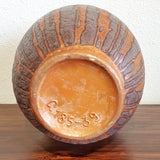


CARSTENS TÖNNIESHOF ‘ATELIER’ SERIES ‘BERLIN’ VASE Nr. 185/39
CONTACT US HERE ABOUT THIS ITEM.
A rare Atelier Series I vase from the CARSTENS TÖNNIESHOF studio collection of 1962/64. The coveted 'Berlin' décor designed by Gerda Heuckeroth applied to an elegant Heinz Siery form C.185/39.
GERDA HEUCKEROTH began her career with an apprenticeship under renowned ceramist Siegfried Möller and studies at the School of Applied Arts in Bremen. She showed her first pieces at the Grassi Museum in Leipzig in 1939. Less than two years later she was appointed the artistic director at Carstens-Uffrect KG in Neuhaldensleben and soon took over the management of the group's Hubbe branch. (The Carstens-Uffrecht factory would be nationalized by the DDR with the division of Germany and operate as VEB Haldensleben up until reunification.) During WWII Heuckeroth set up a workshop in her home in a suburban district of Hamburg. Following the war, she worked for various firms as a designer of both forms and décors, among them Grünstadt, Villeroy & Boch, and the Koninkliijk Plateelbakkerij Zuid Holland in Gouda. Heuckeroth became artistic director of Ruscha Keramik in 1959 when Hanns Welling left the company. She succeeded him again in 1962 as the senior designer for Ceramano. In 1964 she moved to CARSTENS TÖNNIESHOF as head of its 'Atelier' department, where she produced a great number of outstanding designs. Along with much of her early work, these have become highly sought-after by a new generation of collectors. Eventually retiring from industry, Heuckeroth returned to freelancing out of her Hamburg studio. Her work has received numerous awards and prizes over the years at national and international exhibitions.
HEINZ SIERY was a true luminary in the world of ceramics in the 1950s and '60s. His form designs had significant impact on the product styles of makers Fohr, Scheurich, CARSTENS, and Ruscha, among others. Siery often employed "the golden ratio" (or an approximation) while designing, lending harmonious proportion to his work. This can be clearly seen in his most iconic vase, no. 271/22 for Scheurich. Presented in 1959, it was extremely popular and was still being manufactured in the 1970s. Siery also developed and introduced new methods of industrial organization.
In 1969 Siery and wife, Ingrid Siery-Illgner, established a jointly operated studio, Atelier Syré, near the historic town of Euskirchen in North Rhine-Westphalia out of which they both freelanced. (Ingrid had also designed decorative objects for CARSTENS, and overseen the design department at the Wächtersbach earthenware factory.) In addition to commissioned work, the couple produced creations of their own—notably elegant, figural sculptures made of bronze, whose simple, classical forms and sleek lines evoke the work of Henry Moore and Joannis Avramidis. Atelier Syré houses a sculpture park home to more than 300 of these works.
CARSTENS TÖNNIESHOF was founded in 1946 by Ernst Carstens and his son Christian. Their family had had a long prior history of manufacturing ceramics and porcelain in Germany, but all of its businesses had collapsed by the end of WWII. Most of the CARSTENS factories wound up on East German soil when the country was divided and so were expropriated by the DDR. Father and son built the new Tönnieshof factory on a farm of that name in Fredelsloh in Lower Saxony, just west of the border with East Germany. Production of table ceramics began in 1947; the first known decorative pieces date from the early '50s. Ernst's wife Trude Carstens served as artistic director until her death in 1965.
CARSTENS TÖNNIESHOF was very successful for many years and produced an enormous variety of shapes and glazes. The 'Luxus' and 'Atelier' ranges were more expensive lines and were sold in large department stores—'Atelier,' launched in 1962, was the creation of renowned designer Gerda Heuckeroth. Helmut Scholtis introduced the very popular 'Ankara' décor in 1963 during a stint with CARSTENS; an example of the "wax resist" technique, it was applied to a broad array of forms. Lava glazes were employed during the second half of the 1960s. Production was eventually expanded abroad to Austria, Chile, Argentina, and Australia—it may well have topped out at close to 10,000 items daily. Other distinguished designers on CARSTENS' roster included Heinz Siery, Rudolph Christmann, and Dieter Peter. The firm went bankrupt in 1977.
Design Period – 1960-1969
Country of Origin – WEST GERMANY
Designer – GERDA HEUCKEROTH (1917-1993); HEINZ SIERY (b. 1927)
Maker – CARSTENS TÖNNIESHOF
Attribution – WELL-KNOWN
Materials – CERAMIC
Colors – ORANGE, GRAY
Condition – VERY GOOD (no defects; may show slight traces of use)
Height (cm) – 39.0
Diameter (cm) – 23.0



